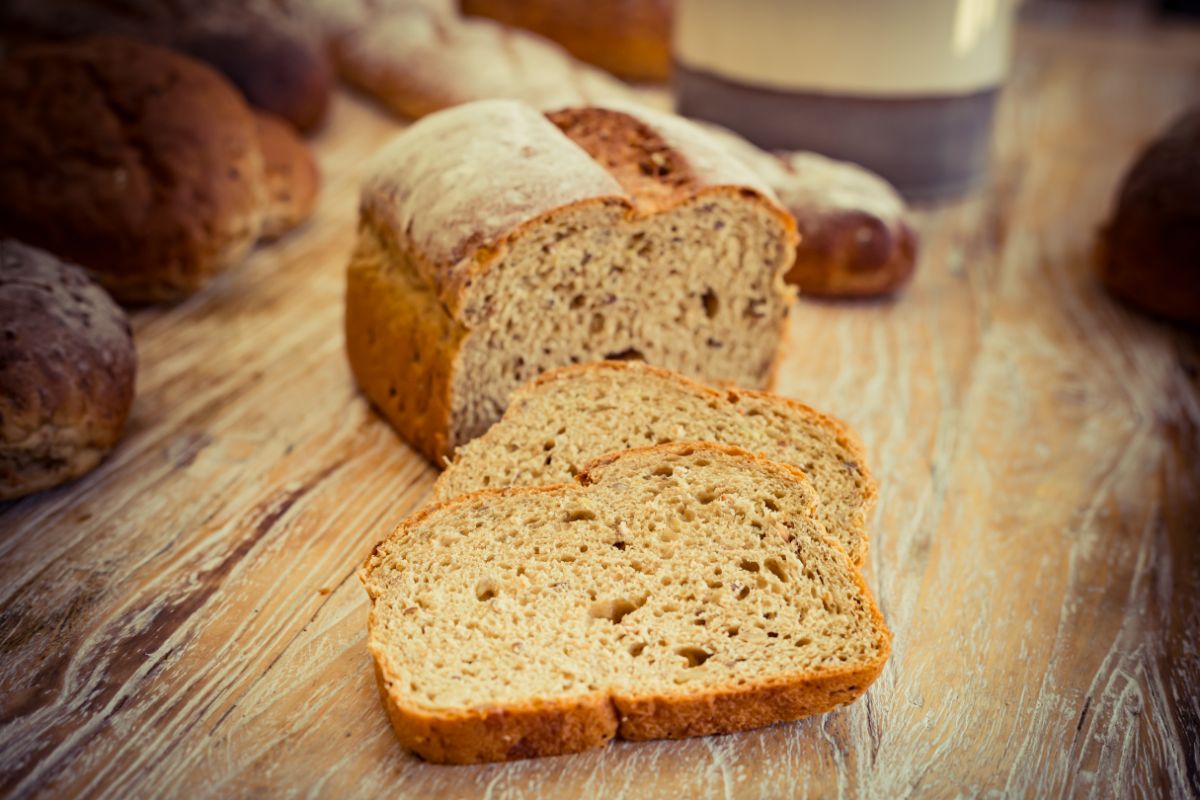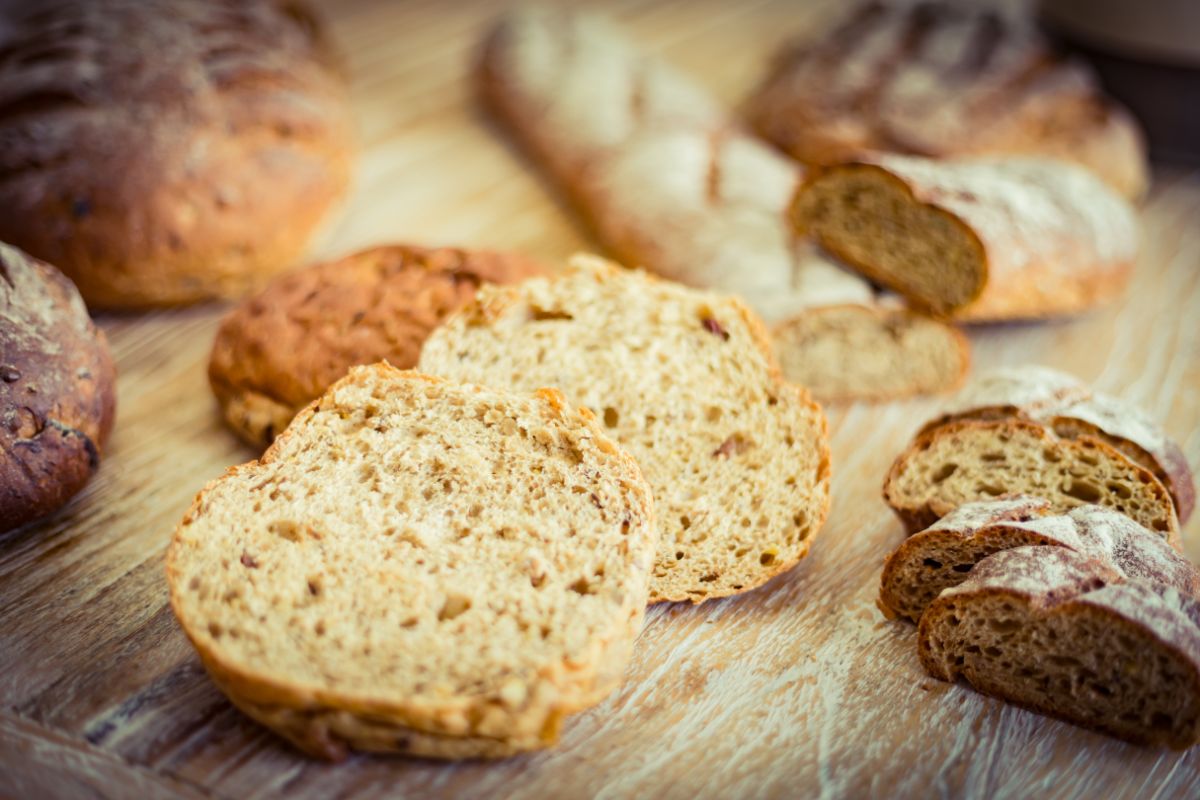The term Ezekiel bread comes from the Bible verse Ezekiel 4:9. This Bible verse says to use wheat, barley, beans, spelt, millet, and lentils in one vessel and use them to make bread.

Spelt is an ancient wheat species used for more than 7000 years considered separate from the high-yield wheat strains that are the basis of the modern diet.
Is Ezekiel bread just a mix of whole grains?
Not quite. Ezekiel bread is a type of sprouted grain bread. While it is based on whole grains (wheat, barley, beans, spelt, millet and lentils), the name brand product takes things one step farther by using whole grains that have begun to sprout.
The grains are ground up and mixed with yeast, wheat gluten, and salt to create a novel whole-grain bread.
What exactly is sprouted grain?
We often forget that grain is grass seed. The sprouted grain process requires soaking the grain in water so that it can start to sprout.
Instead of letting a new blade of wheat, rye or spelt grow, the seeds and sprouts are drained and dried. They’ll be mixed up and ground up into flour.
It is similar to how the germ or outer coat of the wheat kernel is used along with the high carb interior seed, but in the case of sprouted grains, the newly sprouted stem. This is done for health benefits.
How healthy is Ezekiel bread?
The nutritional profile of Ezekiel bread is similar to whole grain flour but somewhat improved. For example, Ezekiel bread is much higher in protein than general whole grain products.
It has around 15 grams of protein per service, while 12-grain breads made with un-sprouted grain have around 11 grams of protein.
It contains a full complement of amino acids, unusual and invaluable in vegan products. Ezekiel bread is typically made without eggs or milk, creating a vegetarian or vegan-friendly baked bread.
It is high in fiber. It has more B vitamins than conventional whole-grain bread. The sprouting gives it several times more folate. Sprouting the grain increases its level of antioxidant vitamins like C, E, and beta-carotene.
What makes Ezekiel bread healthier than the alternatives?

You probably know of the importance of variety in your diet so that you get enough nutrients. We combine rice and beans to create a full protein, whereas one would lack key amino acids if you ate just one or the other.
The same benefit is achieved when you eat the sprouted grain of all six of these legumes and grains. Ezekiel bread provides all nine essential amino acids. It creates a whole, complete protein akin to that found in eggs and milk.
More importantly, there are 18 amino acids as a whole. And for vegetarians and vegans, this makes Ezekiel bread essential, since it is so hard to get some of these amino acids from non-animal sources.
The lack of eggs and milk, as well as general carbohydrates, makes Ezekiel bread diabetic friendly.
The partial sprouting of the grain starts to break down the starch inside the kernels. This lowers its carb content. Regular whole-grain bread has around 45 grams of carbs in one four-ounce, while sprouted whole grain bread has 34 grams of carbs.
White bread would, of course, have more. More important to diabetics is the low glycemic index. Sprouted whole grain bread has the lowest glycemic index of any bread.
It is lower than 12-grain whole-grain bread and sour dough bread. This makes sprouted grain bread like Ezekiel brad a good choice for those who need to maintain their blood sugar since you can eat this without causing your blood sugar to spike.
One argument in favor of sprouted grains is that it reduces the level of “anti-nutrients”. Cooking breaks down many of these enzymes that otherwise interfere in nutrient absorption but not all.
For example, phytic acid remains after you’ve cooked wheat and beans. That anti-nutrient blocks the body’s absorption of iron, zinc, and calcium.
Sprouting, however, breaks down this anti-nutrient. This means that you’ll absorb more of the nutrients in sprouted grain bread than conventional whole grains. Studies have shown it can up to double iron absorption.
Sprouting of the grains breaks down other difficult to digest enzymes like lectins. This makes sprouted whole grain bread more digestible than standard whole grains.
You want to reduce the intake of lectins since this is linked to leaky gut syndrome. Healthy enzymes like amylase and phytase are increased by letting the grain sprout.
To prevent these enzymes from breaking down during the baking process, Ezekiel bread is often cooked at a slightly lower temperature than other whole grain bread.
Is there anyone who shouldn’t eat Ezekiel bread?
This bread is not just high in fiber but high in gluten. This means it isn’t suitable for those with an allergy or reaction to gluten. It is possible to pick up Ezekiel bread that lacks added gluten, though this should be avoided if you have gluten sensitivity.
Or you could search for sprouted bread that uses gluten-free grains like corn, rice, and quinoa.
Can you make your own Ezekiel bread?
Yes, you can, and you don’t even have to buy seeds to sprout and grind up. It is possible to buy sprouted wheat flour to make your own Ezekiel bread at home.
Just make sure you use a recipe that calls for sprouted wheat flour or sprouted multi-grain flour. Many of these recipes do call for butter and eggs in addition to yeast.
Conversely, the added eggs as a binder mean you are free to add dried fruit, nuts, seeds, chia, and flax seeds to it to up the nutritional content. It will typically be cooked at 350 degrees. Cook time will depend on what shape it is in and how large the loaf is.
What is the best way to eat Ezekiel bread?
Ezekiel bread is heavier and denser than bread made from generic wheat flour. You can make a sandwich out of it, but it won’t look or taste like fluffy white bread.
Yet it won’t be a hard cracker. Ezekiel works very well as toast.
